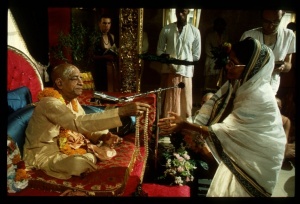CC Madhya 21.105 (1975): Difference between revisions
(Vanibot #0027: CCMirror - Mirror CC's 1996 edition to form a basis for 1975) |
(Vanibot #0020: VersionCompareLinker - added a link to the Version Compare feature) |
||
| Line 2: | Line 2: | ||
<div style="float:left">'''[[Sri Caitanya-caritamrta (1975)|Śrī Caitanya-caritāmṛta (1975)]] - [[CC Madhya (1975)|Madhya-līlā]] - [[CC Madhya 21 (1975)|Chapter 21: The Opulence and Sweetness of Lord Śrī Kṛṣṇa]]'''</div> | <div style="float:left">'''[[Sri Caitanya-caritamrta (1975)|Śrī Caitanya-caritāmṛta (1975)]] - [[CC Madhya (1975)|Madhya-līlā]] - [[CC Madhya 21 (1975)|Chapter 21: The Opulence and Sweetness of Lord Śrī Kṛṣṇa]]'''</div> | ||
<div style="float:right">[[File:Go-previous.png|link=CC Madhya 21.104 (1975)|Madhya-līlā 21.104]] '''[[CC Madhya 21.104 (1975)|Madhya-līlā 21.104]] - [[CC Madhya 21.106 (1975)|Madhya-līlā 21.106]]''' [[File:Go-next.png|link=CC Madhya 21.106 (1975)|Madhya-līlā 21.106]]</div> | <div style="float:right">[[File:Go-previous.png|link=CC Madhya 21.104 (1975)|Madhya-līlā 21.104]] '''[[CC Madhya 21.104 (1975)|Madhya-līlā 21.104]] - [[CC Madhya 21.106 (1975)|Madhya-līlā 21.106]]''' [[File:Go-next.png|link=CC Madhya 21.106 (1975)|Madhya-līlā 21.106]]</div> | ||
{{CompareVersions|CC|Madhya 21.105|CC 1975|CC 1996}} | |||
{{RandomImage}} | {{RandomImage}} | ||
==== TEXT 105 ==== | ==== TEXT 105 ==== | ||
<div class="verse"> | <div class="verse"> | ||
:bhūṣaṇera bhūṣaṇa aṅga, | :bhūṣaṇera bhūṣaṇa aṅga, tāheṅ lalita tribhaṅga, | ||
:tāhāra upara bhrūdhanu-nartana | :tāhāra upara bhrūdhanu-nartana | ||
:terache netrānta bāṇa, | :terache netrānta bāṇa, tāra dṛḍha sandhāna, | ||
:vindhe rādhā-gopī-gaṇa-mana | :vindhe rādhā-gopī-gaṇa-mana | ||
</div> | </div> | ||
| Line 27: | Line 26: | ||
<div class="translation"> | <div class="translation"> | ||
"Ornaments caress that body, but the transcendental body of Kṛṣṇa is so beautiful that it beautifies the ornaments He wears. Therefore Kṛṣṇa's body is said to be the ornament of ornaments. Despite the wonderful beauty of Kṛṣṇa, there is His three-curved style of standing, which beautifies that form. Above all these beautiful features, Kṛṣṇa's eyes dance and move obliquely, acting like arrows to pierce the minds of Śrīmatī Rādhārāṇī and the gopīs. When the arrow succeeds in hitting its target, their minds become agitated. | |||
</div> | </div> | ||
Latest revision as of 13:43, 27 January 2020

A.C. Bhaktivedanta Swami Prabhupada
TEXT 105
- bhūṣaṇera bhūṣaṇa aṅga, tāheṅ lalita tribhaṅga,
- tāhāra upara bhrūdhanu-nartana
- terache netrānta bāṇa, tāra dṛḍha sandhāna,
- vindhe rādhā-gopī-gaṇa-mana
SYNONYMS
bhūṣaṇera—of the ornament; bhūṣaṇa—the ornament; aṅga—the limbs of the body; tāheṅ—that feature; lalita—delicate; tri-bhaṅga—bent in three places; tāhāra upara—above that; bhrū-dhanu-nartana—dancing of the eyebrows; terache—crooked; netra-anta—the end of the eye; bāṇa—arrow; tāra—of that arrow; dṛḍha—strong; sandhāna—fixing; vindhe—pierces; rādhā—of Śrīmatī Rādhārāṇī; gopī-gaṇa—of the gopīs also; mana—the minds.
TRANSLATION
"Ornaments caress that body, but the transcendental body of Kṛṣṇa is so beautiful that it beautifies the ornaments He wears. Therefore Kṛṣṇa's body is said to be the ornament of ornaments. Despite the wonderful beauty of Kṛṣṇa, there is His three-curved style of standing, which beautifies that form. Above all these beautiful features, Kṛṣṇa's eyes dance and move obliquely, acting like arrows to pierce the minds of Śrīmatī Rādhārāṇī and the gopīs. When the arrow succeeds in hitting its target, their minds become agitated.